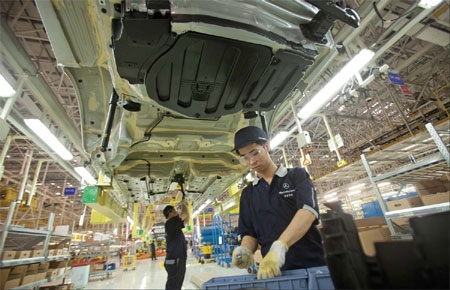Magnet for foreign investment
Updated: 2012-03-23 08:47
By Zhao Yanrong (China Daily)
|
||||||||
|
 Beijing Benz Automotive Co's assembly line in Yizhuang. [Photo by Nelson Ching / Bloomberg] |
Innovative policies, cluster approach give Yizhuang a high-tech edge
When a billboard promoting Yizhuang first appeared in New York's Times Square last year, not too many people had even heard of what was described in the advertisement at the "crossroads of the world". But the high-tech zone in southeast Beijing has been home to more than 4,500 companies, including marquee international names like GE, Nokia, Bayer, ABB and Schneider, apart from also having swanky residential compounds, schools and shopping centers that match up to or in some cases even outrival other economic zones in the world.
Aleksandar Putic has been working with Bayer Healthcare in China for only five months. But his friends and colleagues already consider him to be one of the "lucky ones".
"When 20 of my colleagues, including some senior managers from Spain and the US, visited the Bayer Healthcare facility in Yizhuang, they were really taken in by the state-of-the-art facilities at the Beijing Economic and Technological Development Area (BDA)," Putic says.
But the story of Yizhuang is indeed remarkable considering that it was an obscure and not so popular fishing pond outside Beijing some 20 years ago. Over the years, a slew of preferential policies and new infrastructure have proved to be the magnets for foreign investment in what is now also described as an "e-town" or the destination of choice for high-end manufacturing in China.
Of the 131 State-level economic and technological development zones in China, the Yizhuang BDA, set up in 1992, is 16.5 kilometers away from Tian'anmen Square in Beijing.
"Economic zones have always been the major catalysts for economic growth in China," says Chen Zhiguo, director of the Beijing Fangdi Institute of Economic Development, a think tank specializing in regional economic planning.
"The BDA is the best example of an economic zone dedicated to high-end manufacturing and as such a role model for others, as the focus here is more on scientific and technological innovation, rather than traditional manufacturing," Chen says.
A recent survey revealed that the 90 economic zones in China accounted for more than 15 percent of the nation's foreign trade of $2.68 trillion and attracted 28 percent of the foreign direct investment of $86.68 billion into the country during the first nine months of last year.
Last year, the BDA accounted for nearly 7.2 percent of the total economy in Beijing, with a contribution of about 115 billion yuan ($18.2 billion, 13.7 billion euros), a year-on-year growth of 14 percent. In contrast, the overall average growth rate in Beijing was just 8.1 percent.
But what really tells the Yizhuang story is the more than 4,500 companies from more than 30 countries and regions that are engaged in a host of industrial activities like telecoms, auto, engineering equipment and bio medicine.
There are also 108 programs at the BDA that have received investments from over 75 Fortune 500 companies. Back in 2002, there were only 1,094 companies including 38 Fortune 500 companies located in the BDA.
With such diverse segments of manufacturing, it was only natural that it also spawned distinct clusters focused on the industries. Such clusters have not only helped conserve industry resources, but also led to the development of new technologies.
In Yizhuang, there is an information & communication technology cluster, which is spearheaded by big names like Nokia, Semiconductor Manufacturing International Corp (SMIC) and BOE Technology.

 Relief reaches isolated village
Relief reaches isolated village
 Rainfall poses new threats to quake-hit region
Rainfall poses new threats to quake-hit region
 Funerals begin for Boston bombing victims
Funerals begin for Boston bombing victims
 Quake takeaway from China's Air Force
Quake takeaway from China's Air Force
 Obama celebrates young inventors at science fair
Obama celebrates young inventors at science fair
 Earth Day marked around the world
Earth Day marked around the world
 Volunteer team helping students find sense of normalcy
Volunteer team helping students find sense of normalcy
 Ethnic groups quick to join rescue efforts
Ethnic groups quick to join rescue efforts
Most Viewed
Editor's Picks

|

|

|

|

|

|
Today's Top News
Chinese fleet drives out Japan's boats from Diaoyu
Health new priority for quake zone
Inspired by Guan, more Chinese pick up golf
Russia criticizes US reports on human rights
China, ROK criticize visits to shrine
Sino-US shared interests emphasized
China 'aims to share its dream with world'
Chinese president appoints 5 new ambassadors
US Weekly

|

|






